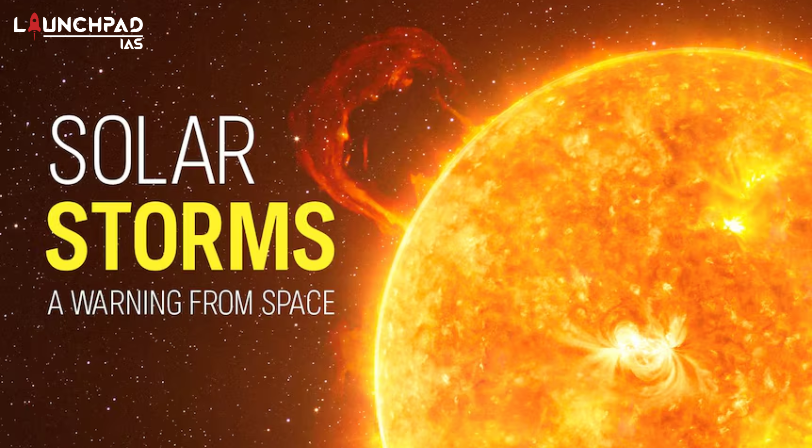- Solar storms (geomagnetic storms) occur when a large-scale magnetic eruption, often causing a coronal mass ejection (CME) and associated solar flare, accelerates charged particles in the solar atmosphere to very high velocities.
- These move toward the Earth at a speed of about three million miles per hour.
- The first recorded solar storm occurred in 1859.
- A powerful solar storm can disrupt the internet, and damage submarine cables and communication satellites.
- Earth’s atmosphere protects us humans from these storms. But the storms can interact with our Earth’s magnetic field, induce strong electric currents on the surface, and affect man-made structures.
- Both NASA and the European Space Agency have probes now that can detect a solar storm. So we can get about 13 hours of warning.
Types of Solar Storms
Solar storms arise in the following varieties:
- Solar flares: A solar flare is an abrupt increase in brightness on the Sun that is typically seen close to its surface or near a group of sunspots. A coronal mass ejection frequently, but not always, occurs together with strong flares. In total solar irradiation, often known as the “solar constant,” even the strongest flares are hardly noticeable.
- Coronal Mass Ejection (CME): The solar corona releases a considerable amount of plasma together with a magnetic field. They frequently appear after solar flares and are typically seen during an eruption of a solar prominence.
- Geomagnetic Storm: A geomagnetic storm, also known as a solar storm, is a brief disruption of the Earth’s magnetosphere brought on by an interaction between the magnetic fields of the Sun and the Earth.
- Solar Particle Events: A solar particle event, also known as a solar proton event (SPE), or prompt proton event, occurs when particles (mostly protons) emitted by the Sun are accelerated either by coronal mass ejection shocks in interplanetary space or by flares that occur close to the Sun during the event.
Effect of Solar Storms
Aurorae
- Cause: When charged particles from the Sun interact with Earth’s magnetic field, they can create vivid displays of light called aurorae.
- Example: The recent aurorae visible over Hanle in Ladakh, India, were caused by a geomagnetic storm.
Power Grid Disruptions
- Cause: Geomagnetic storms can induce currents in power lines, causing voltage fluctuations and potentially damaging transformers.
- Example: In 2003, a geomagnetic storm caused power outages in Sweden and South Africa.
Satellite Damage
- Cause: High-energy particles can damage satellite electronics and affect their operation.
- Example: Satellites used for GPS navigation and communication can be knocked out or suffer reduced functionality during severe solar storms.
Astronaut Safety
- Cause: Increased radiation levels can endanger the lives of astronauts.
- Example: Astronauts on the International Space Station need to take shelter in more shielded parts of the station during solar storms.


